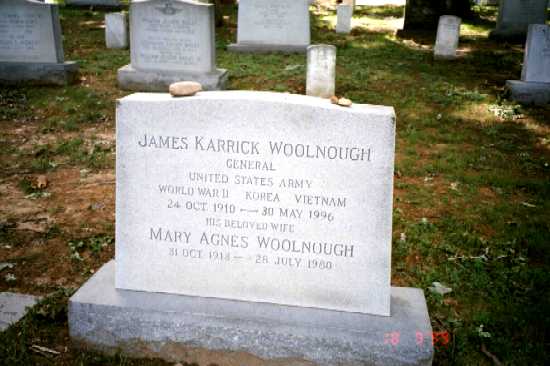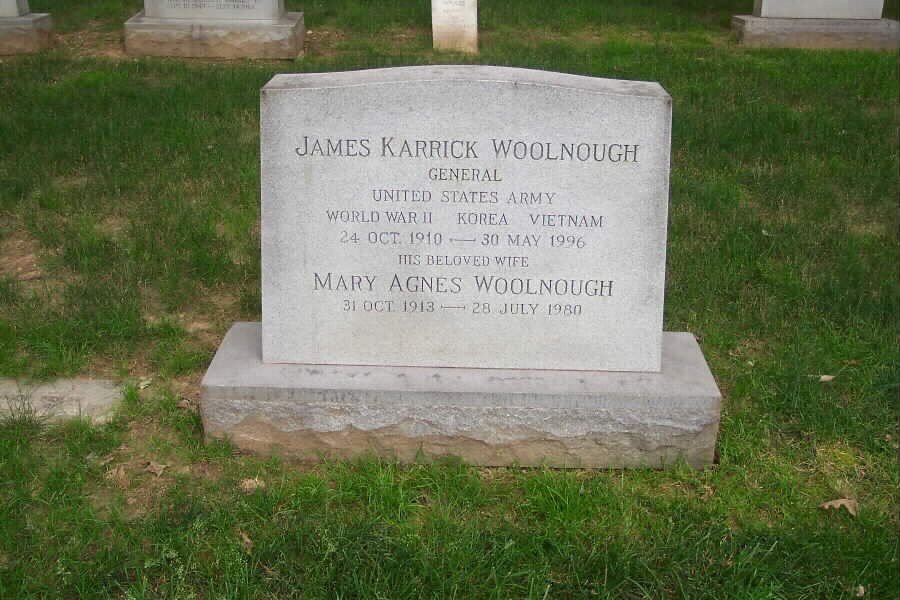James Karrick Woolnough, a retired Army General, 85, who commanded all the active and reserve forces of the Continental Army Command from 1967 to 1970, died of cancer May 30, 1996at Walter Reed Army MedicalCenter. “He was probably the last of the World War II breed. He was quiet, efficient, and everybody who served under him thought he was one of our finest leaders,” family member Keith Fanney said.
During his 38 years on active duty, General Woolnough held a variety of staff and command posts worldwide. In 1944, after the D-Day landing in Normandy, he became executive officer of the 16th Infantry Division. During the Battle of the Bulge that year, he commanded the 393rd Infantry Regiment, 99th Division.
He was born in Mindanao, Philippines, and graduated from the US Military Academy at West Point in 1932. General Woolnough also attended the Infantry School at Fort Benning and the National War College in the District.
In 1950 he was deployed to South Korea to command the 7th Cavalry Regiment. He returned to Korea 11 years later as a Major General. In the Pacific with Joint Force 7, he served as Deputy Plans and Operations officer for the first atomic tests at Eniwetok.
General Woolnough spent 18 years in the Pentagon serving as Chief of Staff of the NATO Standing Group, Director of Plans for the US Army General Staff and Deputy Chief of Staff for Personnel, Department of the Army.
The four-star general's first wife, Mary Agnes Porter, died before him. Survivors include their three children, James Porter Woolnough of Dallas; Marianna Williams of Wintergreen, Va.; and Kenneth Karrick Woolnough of Georgetown, Texas.
He also is survived by wife Mary Dabinet Woolnough of Arlington, seven grandchildren and 17 great-grandchildren.
Burial with full military honors will take place today, June 4, 1996, at 2 pm at Arlington National Cemetery.
USMA 1932. He was buried with full military honors in Section 30, Grave 474, with his first wife, his father and his mother.
Mary Agnes PorterWoolnough, the wife of James Karrick Wollnough. October 31, 1913-July 28, 1980. Section 30, Grave 474.
James Barton Woolnough, Colonel, United States Army. Infantry. World War II. Father of James Karrick Woolnough. October 2, 1879-May 1, 1956. Section 30, Grave 474.
Elsie Kopper Woolnough, the wife of James Barton Woolnough. November 24, 1883-July 23, 1965. Section 30, Grave 474.
Also buried in Arlington is his sister, Ellen Neukerk Woolnough, and her husband, Charles Merriam Tooke, Captain, United States Navy.
HEADQUARTERS
DEPARTMENT OF THE ARMY
Washington, DC, 30 August 1996
General Orders
No. 5
GENERAL JAMES KARRICK WOOLNOUGH
The Department of the Army announces with deep regret the death of General (Retired) James Karrick Woolnough, on May 30, 1996 at Walter Reed Army Medical Center. His last duty assignment was as Commanding General of the United States Continental Army Command, Fort Monroe, Virginia. In this capacity he was responsible for the command and control of all active and reserve forces in the Six Armies of the Continental United States from 1967-1970.
During these turbulent years his prudent use of active forces to augment and support state and federal agencies assisted immeasurably to restore tranquility to many strife-torn cities without excessive loss of life and property. As the U.S. Army was called upon to support the government of South Vietnam, General Woolnough was quick to grasp the need to provide effective pre-deployment training for individuals and units, and rapidly introduced lessons learned into existing training programs. Upon retirement, October 31, 1970, General Woolnough returned to his family home in Arlington, Virginia.
Born on October 24, 1910 in Mindanao, Philippine Islands of Colonel and Mrs. James B. Woolnough, General Woolnough attended the United States Military Academy at West Point, graduating in 1932. Further training included the Infantry School at Ft. Benning and the National War College at Ft. McNair, Washington, D.C. Additionally he was both a math instructor and a Regimental Commander at the Academy.
During his 38 years of active duty, General Woolnough held a variety of staff and command positions worldwide. Shortly after the D-Day Normandy Beach landing, June 1944, he became executive officer of the 16th Infantry, 1st Infantry Division. In February 1945, during the Battle of the Bulge, he assumed command of the 393rd Infantry Regiment, 99th Division, which later provided the vanguard forces to prevent the German destruction of the Remagen Bridge, thus making it possible for the U.S. forces to cross the Rhine.
In September 1950 he was sent to Korea, given a map, and instructed to head north to find the 1st Cavalry Division, which he did and for a time commanded the 7th Cavalry Regiment, the Garry Owen. Eleven years later, as a Major General, he returned to Korea as the 1st Cavalry Commanding Officer.
In the Pacific theater on Joint Task Force Seven he was Deputy Plans and Operations Officer for the first atomic tests at Eniwetok. Years later as a Lieutenant General in 1963, he was Deputy Commander-in-Chief, U.S. Army Pacific at Ft. Shafter, Hawaii.
Among his many assignments during his eighteen years in the Pentagon he served as Chief of Staff of the NATO Standing Group, Director of Operations as well as Director of Plans for the U.S. Army General Staff, and Deputy Chief of Staff for Personnel, Department of the Army.
“Gentleman Jim” was always noted for his quiet, humble and efficient manner. Although he held many awards, medals, and five foreign decorations, he was proudest of his Combat Infantryman's Badge. General Woolnough will be remembered as a “soldier's soldier” for he held the highest respect and admiration for soldiers of all ranks and dedicated his life to their support and well-being.
Michael Robert Patterson was born in Arlington and is the son of a former officer of the US Army. So it was no wonder that sooner or later his interests drew him to American history and especially to American military history. Many of his articles can be found on renowned portals like the New York Times, Washingtonpost or Wikipedia.
Reviewed by: Michael Howard


